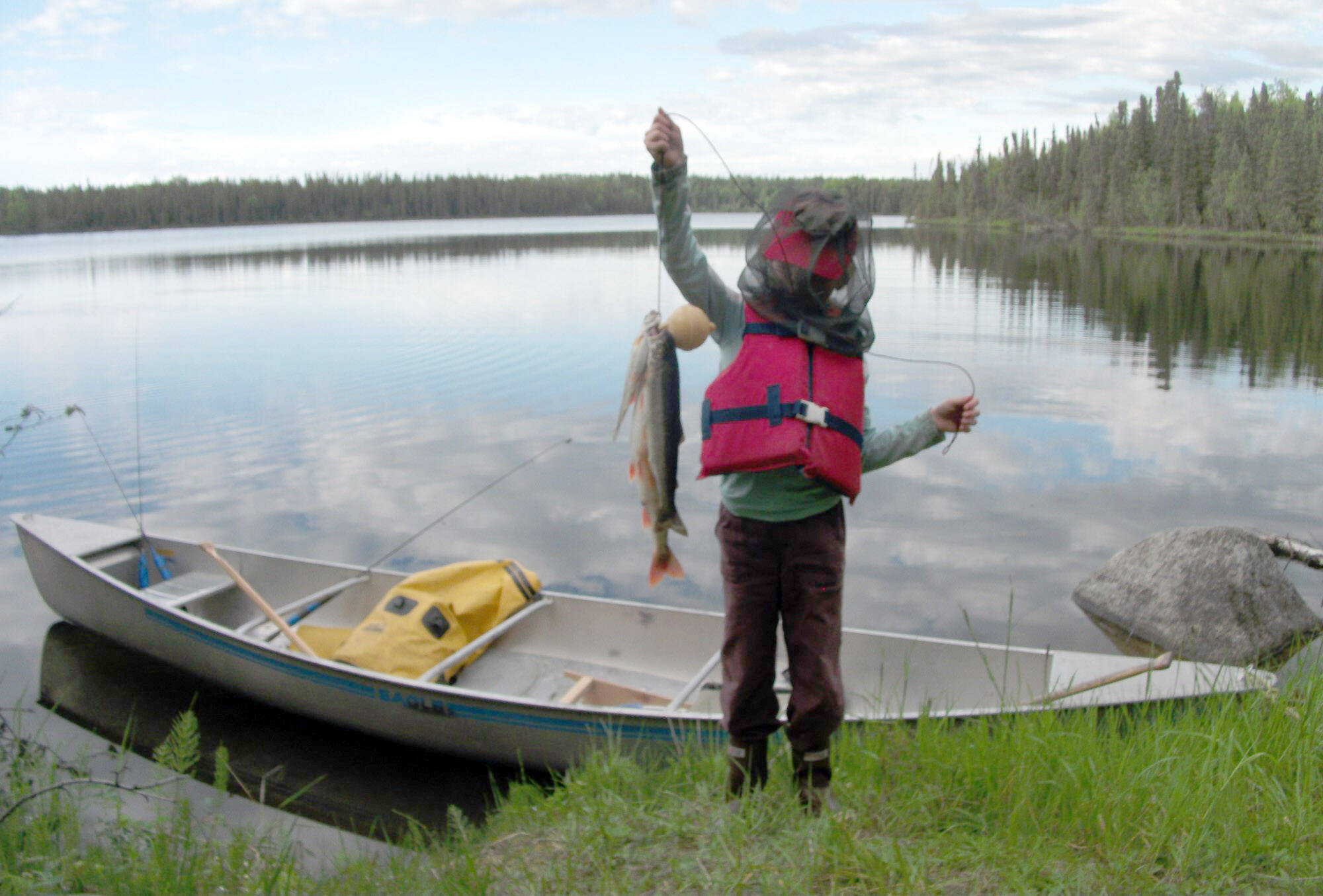One Father’s Day several years ago, my daughter and I drove out to the Drake/Skookum Lake Trail off Swanson River Road. Our goal was to catch an Arctic char.
We had caught most other species in the salmon family that live on the Kenai Peninsula, but we had not seen this special, brightly colored kind of fish.
Taking a snack break along the way, we portaged our gear and aluminum canoe 1 mile down the trail to beautiful Drake Lake.
Once on the water, we cast our lures as far as we could, concerned that the fish might easily perceive our canoe in Drake Lake’s clear water. Glimpses of tree limbs far below gave us an uneasy awareness of the lake’s depth.
At first, we caught a couple of rainbows, which were nice but different from what we were after. Then it happened!
A char from under a partially submerged snag took our lure. I could see its red sides and white-edged fins even from far off. That was a memorable Father’s Day with my daughter!
Others have traveled much farther just to catch an Arctic char. Multiple anglers have traveled from the Lower 48 to lakes off of Swanson River Road in search of Arctic char in partial fulfillment of the Western Native Trout Challenge (westernnativetroutchallenge.org).
This challenge is an invitation to catch 18 native trout and char species within their native ranges across 12 Western states. The ultimate purpose of the trout challenge is to conserve these trout and char species.
Recently, as we at the Kenai National Wildlife Refuge completed a rigorous prioritization process for deciding which species to focus on, Arctic char emerged on the list.
This decision would make sense to Jack Dean, a fishery biologist who, because of his special concern for these unique fish, devoted much of his retirement years to researching them and advocating for their conservation.
Dean identified two threats to Arctic char: invasive northern pike and warming water. Unfortunately, Jack died in 2017, but not before leaving us with much helpful information about our Kenai Arctic char.
He was right about the pike. Stormy Lake in the Swanson River watershed historically provided good fishing for large char, with an estimated 835 char harvested in 1994.
In 2001, the northern pike were confirmed to be present in Stormy Lake. By 2009 and into 2010, 2,000 hours of gillnetting in Stormy Lake yielded only two Arctic char.
In 2011 ahead of a planned effort to eradicate pike from Stormy Lake, the Alaska Department of Fish and Game harvested eggs from Stormy Lake char and milt from Arctic char from Dolly Varden Lake. These were reared in Fort Richardson hatchery in Anchorage.
After successfully eradicating northern pike from Stormy Lake using the pesticide rotenone in 2012, the hatchery-reared Arctic char were released back into the lake. With the pike gone, the char has now recovered well enough that limited fishing for them is again happening at Stormy Lake.
If northern pike had been allowed to persist in Stormy Lake and, from there, dispersed up the Swanson River to other Arctic char lakes, we might have many fewer Arctic char to fish for in the future.
With the last known population of northern pike removed from the Kenai Peninsula in 2021, our char appear to be safer from this threat than they have been for some time. However, the other threat might be harder to overcome.
As their name suggests, Arctic char like cold. They become inactive when water temperatures rise to about 50 F. On the Kenai Peninsula, they live only in deep lakes where at least some of the water column remains cold year-round.
Over the warm summer of 2015, many stocked Arctic char died in Southcentral Alaska lakes as water temperatures reached 70 F. If Kenai Peninsula lakes become warmer, then some current char lakes may become uninhabitable.
Besides his concerns for their future, Jack Dean had wanted to know all the places where native Arctic char now live on the Kenai Peninsula, how they got there, and how they were related to other stocks of Arctic char around the Arctic.
At this point, we have limited genetic information from Kenai Peninsula char. Still, we know that our fish are closely related to Arctic char from the Mat-Su and Kodiak, indicating that these stocks share a common origin.
Jack Dean worked hard to find char in as many Kenai Peninsula lakes as he could, either by digging through old reports or portaging his canoe out to remote lakes.
He documented char in just over 50 lakes in the Swanson River watershed and two lakes (Copper and Char lakes) in the Kenai River drainage. He also recommended checking several lakes where Arctic char might live but where they have not yet been documented.
Following one of Jack’s suggestions, my son and I paddled and portaged out to Junco Lake and several lakes out on the Swanson River Canoe Route in October. We spent most of our day getting to this lake and back.
Unfortunately, we did not find any char at Junco Lake, but we did catch one nice rainbow! I was grateful to have the opportunity to be fishing with my son. It is beautiful country.
We at the refuge intend to follow up on Jack Dean’s work on Arctic char and step up our surveillance for invasive northern pike on the Kenai Peninsula. In doing so, we can better ensure Arctic char persist in our lakes and provide opportunities for people to enjoy these unique, colorful fish for the foreseeable future.
Matt Bowser serves as a Fish and Wildlife Biologist at Kenai National Wildlife Refuge. See Jack Dean’s reports on Arctic char at bit.ly/3Bf17Es and bit.ly/3UHaxj9 . Find more Refuge Notebook articles (1999–present) at https://www.fws.gov/kenai-refuge-notebook.


